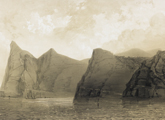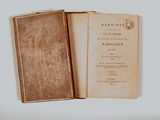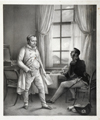1. The island and its lanscape
A small volcanic island measuring 122 square kilometres, Saint Helena is one of the remotest places on Earth, stranded in the Atlantic Ocean over 2,000 kilometres from the coast of Africa. Between the often idyllic depictions of the island and the reality of its inhospitable climate, Napoleon on Saint Helena provides a window into the final setting of the Napoleonic adventure. Through maps and views from the time, visitors are invited to follow in the Emperor’s footsteps, from the spiny and hostile landscape of Saint Helena, abundantly represented in prints from the period, to the wet plains of Longwood where the only respite from boredom was death.2. Material conditions during exile
Despite his hasty departure, Napoleon managed to take many pieces of furniture and objects from the palace with him. These items were crafted by the finest artists and artisans of the time, such as the Athenian by Biennais, the special dinner service produced by the Sèvres Imperial Manufactory or the ivory miniatures painted in minute detail by Isabey. He also transported objects of more sentimental value, beginning with his campaign bed that accompanied him during his greatest victories and which, while not gilded in fine gold, shows an ingenious design that visitors are sure to appreciate.Longwood and these treasures, vestiges of bygone imperial splendour, resonate with the living conditions of a prisoner who was supplied with simple even basic furniture, either found on the island or made from resources to hand. The simple juxtaposition of these objects presents visitors with a clear picture of the insolvable ambiguity of the status and existence of a fallen Emperor.
3. Rise of the legend
Longwood House was the stage of the last of the Emperor’s battles, his conquest for posterity. Contradicting the old adage that history is written by the victors only, Napoleon set about recording his own legend. For this, he was able to count on the young Las Cases, an indefatigable scribe, called upon at all hours, day and night, to put down on paper an account of the Emperor’s past glories as well as the trials and tribulations of recent years. This frenetic period of writing culminated in Le Mémorial de Sainte-Hélène, a best-seller that sent political shock waves through Europe in the 19th century. The exhibition presents the writing produced on Saint Helena, the words dictated by the Emperor as well as the testimonials of his companions in exile that contributed to the creation and rise of the legend.Thus, on the steep rocks of Saint Helena, the figure of Napoleon as a talented writer, fighting against oblivion, was born.









